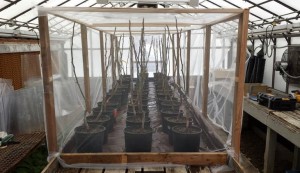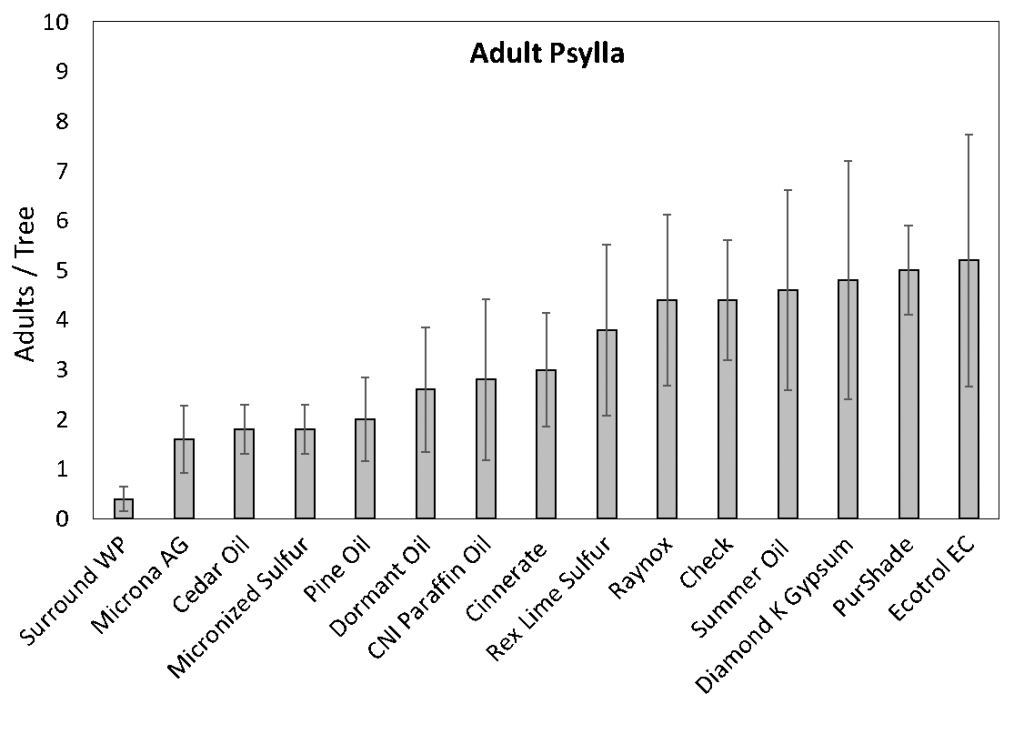by Louis Nottingham and Betsy Beers, Updated Winter 2020.
Growers are asking about a number of new and old materials designed to repel winterform psylla adults from entering the orchard and reduce egg laying. Below are the results from the first round of assays screening 14 materials.
Background
Pear psylla control is becoming increasingly difficult, especially in regions of the Pacific Northwest like the Wenatchee Valley where pear orchards dominate the landscape. In high pressure locations, an important factor in pear psylla control is delaying their immigration and egg laying in the early spring. A method that is gaining popularity is early season repellency, as is seen in the increased use of the kaolin clay product Surround WP. Repelling overwintered adults during the early season delays egg laying until later in the spring, which causes psylla generations to occur in clear increments, and thus allowing for more precise insecticidal control. Additionally, trying to control overwintering adults with insecticides is often a fruitless effort (no-pun intended), because of their high mobility among orchards and uncultivated areas, as well as their increasing resistance to most insecticides. Due to the success of Surround WP as a repellent, we sought to determine if other agricultural and non-agricultural products may also act as repellents for overwintering psylla. Products were chosen based on stated interest from field advisors, growers or researchers. Table 1 has each product listed and the reason it was chosen.
Methods

Individual pear trees (potted d’Anjou, two years old, bud-break stage) were sprayed with materials and placed into a large cage in the greenhouse (Fig. 1). Overwintering psylla were collected from an untreated pear Orchard in Wenatchee in March of 2017, and released into the cage. After a week, adults and eggs were counted on each pear tree. Two identical experiment were conducted; each containing 3 replicates of treatments.
Results
Although there were few statistical differences in this trial, the observed trends may help narrow down which materials are worth pursuing in future experiments and field trials. Overall, Surround had the lowest numbers of psylla adults (Fig. 2) and eggs (Fig 3). It was the only treatment to result in significantly fewer psylla than the check (eggs, Fig. 3). Cedar oil, pine oil, Micronized Sulfur and Microna AG also seem to be in the upper bracket of repellency. CNI paraffin oil, dormant oil and Cinnerate showed moderate repellency; while the rest did not appear to have a detectable effect. Additionally, no materials resulted in visibly detectable phytotoxicity.
Conclusions
Surround WP appears to be the best product for repelling adult psylla, of those we tested. There is certainly potential for other products such as the Surround-like products (Microna appears especially promising based on these results) and conifer oils. Surround-type products should be of particular interest for a few reasons. Surround WP is becoming more expensive with greater use, and seasonal demand often outweighs the supply. Although, similar products were not as effective in this trial, field results may differ. Also, formulations may improve in the future to increase efficacy; remember, the formulation for Surround has changed and improved since initial release. Conifer oils (pine and cedar) are probably too expensive to justify largescale use, currently. However, these products are not manufactured for agricultural use, which could change if the using conifer oils appears to be a method worth pursuing. It is reasonable to think that an agricultural-use product could be developed for a reasonable price if the demand is present.
Table 1. Product list and reason for selection in trial
| Trt | Product | AI in product: product/200 ml |
Expected type of repellent and reason for selection |
| 1 | IAP 440 (summer) | 98.5% mineral oil: 8 ml | Tactile repellent. Commonly mixed with insecticides. |
| 2 | IAP 470 (dormant) | 98.5% mineral oil: 8 ml | Tactile repellent. Commonly mixed with insecticides. |
| 3 | CNI Paraffin Oil² | Mineral oil: 2 ml | Tactile repellent. Commonly mixed with insecticides. |
| 4 | Rex Lime Sulfur | 28% calcium polysulfide: 14 ml |
Olfactory repellent. Strong smell of sulfur which is toxic to many arthropods. |
| 5 | Cedar Oil¹,² | 100% cedar essential oil (Jedwards Inc.): 4 ml | Olfactory repellent. Psylla thought to migrate away from conifers (overwintering sites) in early spring. |
| 6 | Pine Oil¹,² | 100% pine essential oil (Jedwards Inc.): 4 ml | Olfactory repellent. Psylla thought to migrate away from conifers (overwintering sites) in early spring. |
| 7 | Cinnerate | 60% cinnamon oil: 4 ml | Olfactory or tactile. Strong smell and known toxin to mites and soft-bodies insects. |
| 8 | Ecotrol EC | 10% rosemary oil and 2% peppermint oil: 1 ml | Olfactory repellent. Strong smell and occasional use as insecticide |
| 9 | Raynox² | Carnauba wax and modified clay: 12 ml | Tactile repellent or visual masking. Similar to Surround. Liquid formulation of clay product. |
| 10 | PurShade² | 62.5% calcium carbonate: 5 ml | Tactile repellent or visual masking. Used for protection against fruit sunburn. |
| 11 | Surround WP | 95% kaolin clay: 20 g | Tactile repellent or visual masking. Unpleasant powdery/dry surface. Odd color prevents host detection. |
| 12 | Diamond K Gypsum¹,² | 52% potash (K2O) and 18% sulfate (SO4): 20 g | Tactile repellent or visual masking. Similar to Surround. |
| 13 | Microna AG² | 95% calcium carbonate: 20 g |
Tactile repellent or visual masking. Similar to Surround. |
| 14 | Microthiol Disperss Wettable Sulfur | 80% sulfur: 13.6 g | Olfactory repellent. Strong smell of sulfur which is toxic to many arthropods. |
| 15 | Check | H2O | — |
| ¹Use as a foliar application in pears is not stated on label and is not exempt from FIFRA under the Minimum Risk Exemption regulations in 40 CFR 152.25(f).
²Pear psylla is not listed on label as a target control organism. |
|||


Disclaimer
Some of the pesticides discussed in this presentation were tested under an experimental use permit granted by WSDA. Application of a pesticide to a crop or site that is not on the label is a violation of pesticide law and may subject the applicator to civil penalties up to $7,500. In addition, such an application may also result in illegal residues that could subject the crop to seizure or embargo action by WSDA and/or the U.S. Food and Drug Administration. It is your responsibility to check the label before using the product to ensure lawful use and obtain all necessary permits in advance.
Use pesticides with care. Apply them only to sites listed on the labels. When mixing and applying pesticides, follow all label precautions to protect yourself and others around you. It is a violation of the law to disregard label directions. If pesticides are spilled on skin or clothing, remove clothing and wash skin thoroughly. Store pesticides in their original containers and keep them out of the reach of children, pets, and livestock. The information in this correspondence is not meant to endorse the use of any product.
